- Article
tells about the evolution of Indian musical instruments since the Vedas,
through the Epics and Samrithis to the present.
Can we ever think of Krishna without his flute, Devi Saraswati without a Veena, Shiva without a Damru, or Narada without his Tambura?
The Indian Musical Instruments have been associated, not only with our God's & Goddesses but are also an indispensable part of our Indian culture and traditions since ancient times. Here is a journey into the evolution of Indian musical instruments as we find traces of them evolving since the time of Vedas, Epics and Samrithis to the present.
In his
Samrithi Sage Yagnavalka refers to the Veena saying, “Whoever knows the secrets
to play the Veena, can easily get to the path to Moksha.”
According
to the Nitya Grantha, Ramanujacharya spoke about the ancient religious
practice in temples. When the deity was being decorated (Alankarasana) they were worshipped with
dance in accompaniment of Veena and the Flute.
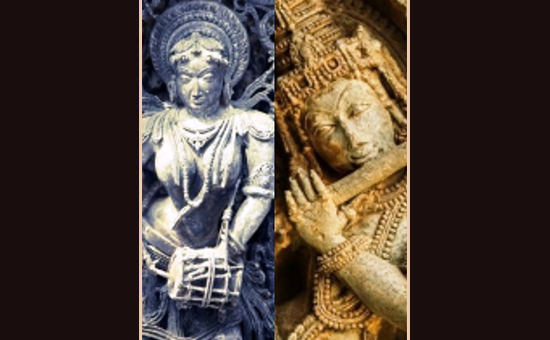 Sculpture with flute and drums
Sculpture with flute and drums The practice of worshipping God with musical instruments is still evident in many temples across India especially, Shri Nathji and the Shri Dhwarikadheesh Temple in Mathura. There are eight occasions to sing to the 'Lord of Dwarka' who's worshipped as a young Krishna of Vrindavan. Starting with an early morning Arti to wake Him, to the time when he sleeps, the Seva begins with devotional Dhrupads and compositions which are sung in front of the Lord in accompaniment of Shankh, Ganta, Dhol, Manjeera and Mridanga. This tradition represents the Haveli Sangeet Repertoire which originated in Mathura and Brij.
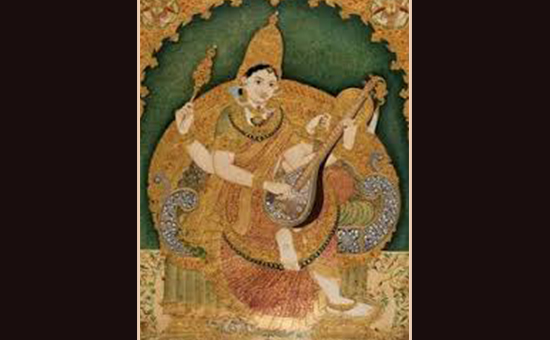 Tanjore Painting showing a Veena.
Tanjore Painting showing a Veena. If we go back
to the sources of information on Indian musical instruments we find them in
several Sanskrit treatise, sacred books, works of literature, science,
music, ancient sculptures, frescoes and paintings and folklore.
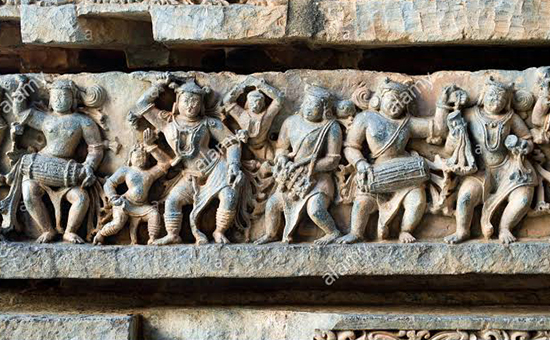 Sculpture with a musical procession with Mridanga.
Sculpture with a musical procession with Mridanga.Vedic texts like Atharva Veda, Bhagvata Purana, Buddhist and Jataka Stories, all mention numerous musical instruments. So does the treatise on Music the 'Natyashastra' of Bharata Muni, 'Sangeet Ratnakar' of Sarangdeva and 'Raga Vibodh' of Somnath. The literary works of Kalidasa's 'Abhigyan Shakuntalam' in Sanskrit to Abul Fazal's Ain-i-Akbari also give reference of musical instruments in their respective eras.
In the frescos of Ajanta, Ellora, Bagh Caves, the Muslim miniature paintings, Tanjore paintings, Raga Ragini paintings of Rajasthan to Paintings of Raja Ravi Verma we see beautiful figurative art with musical instruments depicting the musical concerts. This all tells us how deeply music captured the souls right from an ancient man till today.
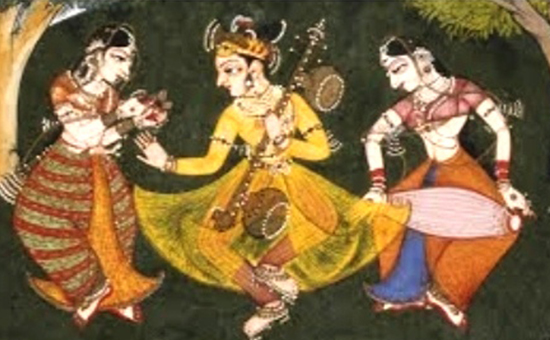 Ragamala Painting showing a Jantar a Fretted Veena and Mridanga.
Ragamala Painting showing a Jantar a Fretted Veena and Mridanga.Since ancient times, the Veena has been the most commonly depicted instruments in Indian iconography through paintings and sculptures, which has been played in both the South and North Indian classical music styles. Veena is found in many forms including the Rudra Veena, Saraswati veena, Jantar. Popularly known as the Been in the Dhrupad Gharanas,
Veena which is considered as the predecessor of the Sitar.
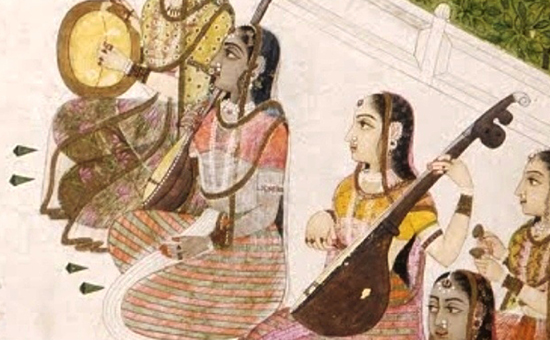 Painting showing Musical Concerts.
Painting showing Musical Concerts. Looking
at the musical instruments of today, we find that they went through a long
process of evolution and development through several centuries to reach the
highly developed forms that we find them in now. In the due course of time,
many instruments became obscure, as new instruments suiting the need of the
time developed, in terms of the playing technique, designs and their usage.
Thus, we
find that the ancient string instruments like Ambuja, Alpine, Pariwadhi and Mattakolila
evolved into modern Veena, Sitar, Sarod and Israj. While the percussion
instruments like Bheri, Dhundhubi and other ancient drums developed into
Mridangam, Tabla and Pakhawaj.
According
to the Natyashastra of Bharat, there are four classes of musical instruments:
Tat or Tantu Vadya (string), Sushir Vadya (wind), Awanadh Vadya (percussion or drums), Ghana Vadya (bells, cymbals and gongs).
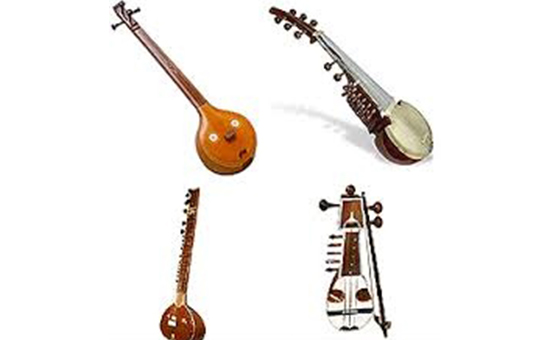 Stringed instruments collage.
Stringed instruments collage.'Tat Wadya' are the String instruments (chordophones) wherein the strings are plucked to create the sound. They are of four types to include 'Plucked instruments' like the Tanpura, Sitar, Swarmandal Mohan Veena, Rudra veena, Saraswati Veena, Jantar, Ektara. They are played with the fingers, thumb, or a plectrum to pluck the string. The 'Stroking instruments' like Sarod, Rebab are stroked with the help of the nail or a Plectrum. The 'Bowed instruments' like Sarangi, Israj and violin are played with a Bow, while the 'Hammered instruments' like Santoor is struck with wooden mallets, called 'Mezrab' which causes the strings to vibrate across the soundboard.
Looking at the ancient string instruments we find that the strings were made of hair, weeds and animal skin. It's believed that the early man got to know about the sound of the bow releasing an arrow during hunting, while mythology states that the string instruments were created by the Bow of Shiva.
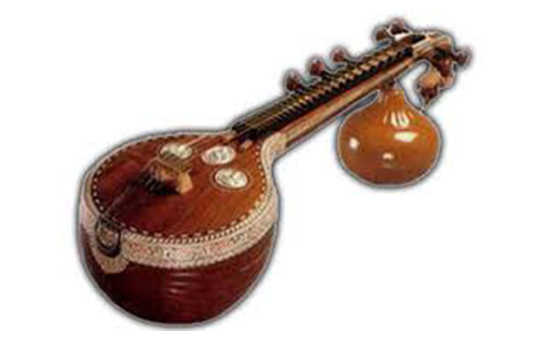 Veena.
Veena. Looking
at the present string instruments we find a variation in shapes, sizes and the
number of strings in every instrument, while they all have in common, a sound
bridge to which the strings are attached. It is to note that the frequency of
the sound depends on the length of the string and also on the distance from the
sound bridge. Looking at the evolution of the stringed instruments we also find
that in the early times the stringed instruments had no frets and sympathetic
strings, which were introduced in later times.
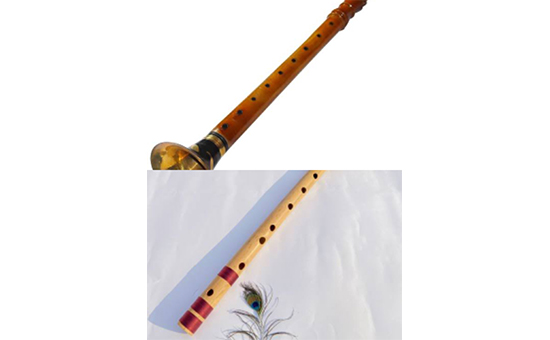 Flute and Shehnai.
Flute and Shehnai.Sushir means a hole. The 'Sushir Wadya' include the Wind instruments (Aerophones) like the Bansuri, Shehnai and Nagaswaram wherein the wind is blown inside the hole to produce the sound. These instruments have an air column made up of Bamboo, Wood or Metal with holes to produce various notes.
Wind
instruments are classified based on the mode of playing. The first being the
instruments in which the wind is supplied mechanically like Harmonium, while
the second type is the mouth-blown instruments in which the wind is supplied
with the breath like the Shehnai and the Flute. With regards to the evolution
of wind instruments, we find that the primitive flutes had only two or three
holes at the beginning, which were the vertical type. While the flute developed
over time into transverse flutes with seven holes.
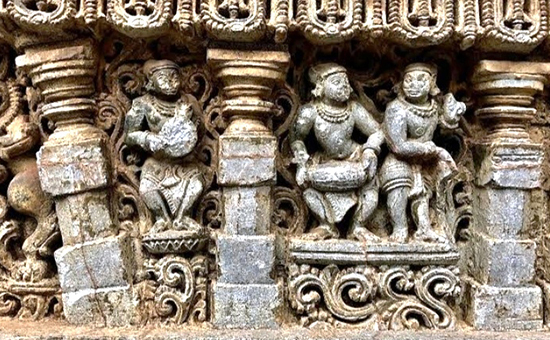 Sculpture presenting Membranophones.
Sculpture presenting Membranophones.'Awanadhha Wadya' are the Percussion instruments made with animal skin (membranophones) which are used in classical performances both for accompaniment and solo concerts. There are four types of percussion instruments.
Those
played with palms and fingers of both hands like Tabla, Pakhawaj, Mridangam, Dolki and Dholak. Those
played with the sticks like Dhol, Nagada and Sambal. Those playing with the
fingers like Duff, Janjira and Dimli, and those Instruments which have a thread
tied in the centre, which strikes at membranes at both ends to produce sound,
like a Damru.
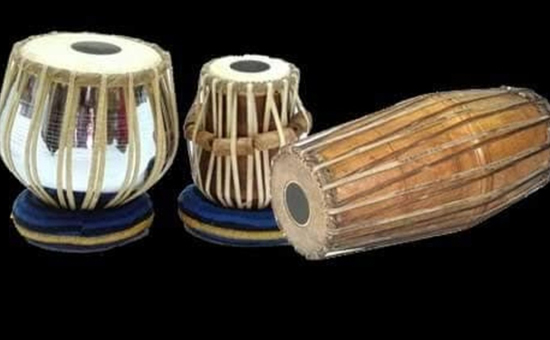 Mridang & Tabla.
Mridang & Tabla. In regards to the percussion instruments, we find that a variety of pots and crude drums were used in the primitive days, which were the forerunners of Mridangam and Tabla. Looking at the construction of the instruments we find that Mridangam, Pakhawaj and Tabla are made of several layers of skin, while a black tuning paste 'Siyahi' is applied at the centre of the faces which helps in tuning them to the required pitch. The Mridangam happens to be the oldest instrument which is considered to be the most developed instrument of South India i.e. mainly used in Carnatic music.
Tabla is a combination of two drums Bayan (played on the right side) which is slightly bigger and is made of Metal and Dayan (played on the left side) both being played simultaneously. Both the drums are covered with multiple layers of skin on the face, wherein the tuning ink 'siyahi' is added on the top. It is to note the Siyahi on the Bayan is put slightly off-centre. This allows the performer in generating a wide variety of tones and change the pitch of the instrument by applying variable pressure on the skin, with the palm of the right hand, while he strikes it with the fingertips.
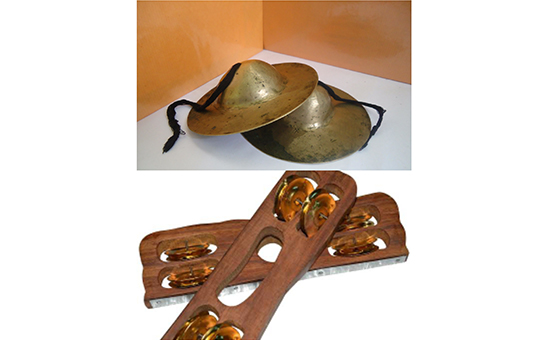 Manjira & Kartal.
Manjira & Kartal.'Ghan Wadya' are the Solid instruments or Cymbals (A-tonal non-Percussion instrument) which are made of hard surfaces such as metal and wood like the Jhanjh, Manjira, Kartal.
Ghan
Vadya is further classified based on their usage which are of two types.
The instruments which are played with hands like a Chipli or those played with
a stick like Jaltarang, Ghanta. The instruments which are played with free
movement or rotation like Ghungroo, Rattle, Ghantika and Kabas. They are called
A- tonal because they cannot produce notes and are used only to maintain the
Rhythm or tempo.
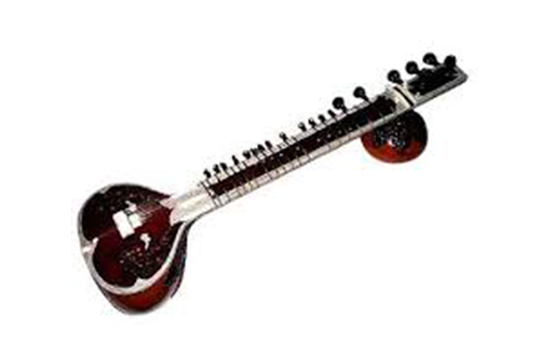 Sitar.
Sitar. Over the
centuries there have been a lot of foreign influences on not only Indian
culture but also our music and musical instruments. In the Mughal Period, the
music of North India began to acquire and adapt to the Persian language, music,
and musical instruments, eminently introduced by Hazrat Amir Khusro who was of Turkish
origin. Khusro was a refined musician, poet and intellectual who adorned the
courts of 7 Sultans of Delhi.
Sitar is attributed to be his innovation, which was originally called a 'Seh- Tar' in Persian, which means an instrument with three strings. During this time instruments like Kamancheh and Santoor were also adopted from Persia which became popular in Kashmir.
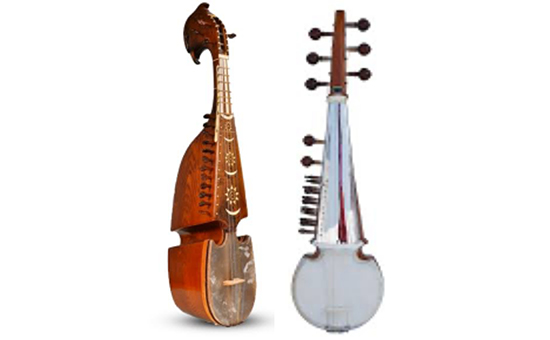 Sarod & Rebab.
Sarod & Rebab.While, the Sarod and Rebab have been adopted from Afghanistan, and it is believed that 'the king of flutes' Shehnai was also developed in the Mughal era. Indian classical music has also adopted the violin from the west which was introduced in the last century. Although its technique and style of playing Hindustani classical music are entirely Indian.
India too has gifted the world with many precious gems from its kitty as part of both merchandise and cultural exchanges over the centuries. The Indian instruments like the Bow were known in India since ancient times, which has travelled to other parts of the world. It is believed to be the predecessor of many other stringed instruments such as the Sarangi and the Chinese Erhu.
Later the bow was adopted by the Persians and spread to the Muslim countries and further to the west when they came under the influence of Arabs. Another gift from India to the west is the transverse flute. Also several Indian instruments like Tambura, Tabla, Sarangi and Sitar were taken, over the centuries, to many countries like Turkey, Mongolia, China and Indonesia.
To read all
articles by author